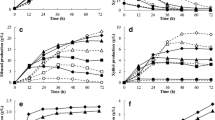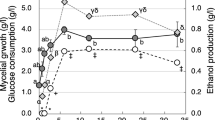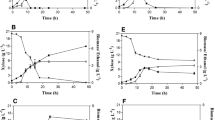Abstract
A new fungus, Pestalotiopsis sp. XE-1, which produced ethanol from xylose with yield of 0.47 g ethanol/g of consumed xylose was isolated. It also produced ethanol from arabinose, glucose, fructose, mannose, galactose, cellobiose, maltose, and sucrose with yields of 0.38, 0.47, 0.45, 0.46, 0.31, 0.25, 0.31, and 0.34 g ethanol/g of sugar consumed, respectively. It produced maximum ethanol from xylose at pH 6.5, 30°C under a semi-aerobic condition. Acetic acid produced in xylose fermenting process inhibited ethanol production of XE-1. The ethanol yield in the pH-uncontrolled batch fermentation was about 27% lower than that in the pH-controlled one. The ethanol tolerance of XE-1 was higher than most xylose-fermenting, ethanol-producing microbes, but lower than Saccharomyces cerevisiae and Hansenula polymorpha. XE-1 showed tolerance to high concentration of xylose, and was able to grow and produce ethanol even when it was cultivated in 97.71 g/l xylose.





Similar content being viewed by others
Abbreviations
- GC:
-
Gas chromatography
- HPLC:
-
High-performance liquid chromatography
References
Aristidou A, Penttilä M (2000) Metabolic engineering applications to renewable resource utilization. Curr Opin Biotechnol 11:187–198
Brat D, Boles E, Wiedemann B (2009) Functional expression of a bacterial xylose isomerase in Saccharomyces cerevisiae. Appl Environ Microbiol 75:2304–2311
Chu BCH, Lee H (2007) Genetic improvement of Saccharomyces cerevisiae for xylose fermentation. Biotechnol Adv 25:425–441
Dien BS, Cotta MA, Jeffries TW (2003) Bacteria engineered for fuel ethanol production: current status. Appl Microbiol Biotechnol 63:258–266
du Preez JC (1983) Fermentation of d-xylose to ethanol by a strain of Candida shehatae. Biotechnol Lett 5:357–362
Edgardo A, Carolina P, Manuel R, Juanita F, Baeza J (2008) Selection of thermotolerant yeast strains Saccharomyces cerevisiae for bioethanol production. Enzyme Microbiol Technol 43:120–123
Gírio FM, Fonseca C, Carvalheiro F, Duarte LC, Marques S, Bogel-Łukasik R (2010) Hemicelluloses for fuel ethanol: a review. Bioresour Technol 101:4775–4800
Hahn-Hägerdal B, Karhumaa K, Fonseca C, Spencer-Martins I, Gorwa-Grauslund MF (2007) Towards industrial pentose-fermenting yeast strains. Appl Microbiol Biotechnol 74:937–953
Jeewon R, Liew ECY, Simpson JA, Hodgkiss IJ, Hyde KD (2003) Phylogenetic significance of morphological characters in the taxonomy of Pestalotiopsis species. Mol Phylogenet Evol 27:372–383
Jeffries TW, Jin YS (2000) Ethanol and thermotolerance in the bioconversion of xylose by yeasts. Adv Appl Microbiol 47:221–268
Jeffries T, Shi NQ (1999) Genetic engineering for improved xylose fermentation by yeasts. Adv Biochem Eng Biotechnol 65:117–161
Jeffries TW, Grigoriev IV, Grimwood J, Laplaza JM, Aerts A, Salamov A, Schmutz J, Lindquist E, Dehal P, Shapiro H, Jin Y-S, Passoth V, Richardson PM (2007) Genome sequence of the lignocellulose-bioconverting and xylose-fermenting yeast Pichia stipitis. Nat Biotechnol 25:319–326
Matsushika A, Inoue H, Murakami K, Takimura O, Sawayama S (2009) Bioethanol production performance of five recombinant strains of laboratory and industrial xylose-fermenting Saccharomyces cerevisiae. Bioresour Technol 100:2392–2398
Metz AM, Haddad A, Worapong J, Long DM, Ford EJ, Hess WM, Strobel GA (2000) Induction of the sexual stage of Pestalotiopsis microspora, a taxol-producing fungus. Microbiology 146:2079–2089
Meyer PS, du Preez JC, Kilian SG (1993) Effect of temperature and pH on Candida blankii in chemostat culture. World J Microbiol Biotechnol 8:434–438
Meyrial V, Delgenes JP, Romieu C, Moletta R, Gounot AM (1995) Ethanol tolerance and activity of plasma membrane ATPase in Pichia stipitis grown on d-xylose or on d-glucose. Enzym Microbial Technol 17:535–540
Oliva JM, Negro MJ, Sáez F, Ballesteros I, Manzanares P, González A, Ballesteros M (2006) Effects of acetic acid, furfural and catechol combinations on ethanol fermentation of Kluyveromyces marxianus. Process Biochem 41:1223–1228
Parshikov IA, Heinze TM, Moody JD, Freeman JP, Williams AJ, Sutherland JB (2001) The fungus Pestalotiopsis guepini as a model for biotransformation of ciprofloxacin and norfloxacin. Appl Microbiol Biotechnol 56:474–477
Schnerder H, Wang PY, Chan YK, Maleszka R (1981) Conversion of d-xylose into ethanol by the yeast Pachysolen tannophilus. Biotechnol Lett 3:92–98
Sommer P, Georgieva T, Ahring BK (2004) Potential for using thermophilic anaerobic bacteria for bioethanol production from hemicellulose. Biochem Soc Trans 32:283–289
Steyaert RL (1953) New and old species of Pestalotiopsis. Trans Brit Mycol Soc 36:81–89
Turenne CY, Sanche SE, Hoban DJ, Karlowsky JA, Kabani AM (1999) Rapid identification of fungi by using the ITS2 genetic region and an automated fluorescent capillary electrophoresis system. J Clin Microbiol 37:1846–1851
Wang PY, Shopsis C, Schneider H (1980) Fermentation of a pentose by yeasts. Biochem Biophys Res Comm 94:248–254
Zaldivar J, Nielsen J, Olsson L (2001) Fuel ethanol production from lignocellulose: a challenge for metabolic engineering and process integration. Appl Microbiol Biotechnol 56:17–34
Zeng AP, Biebl H, Deckwer WD (1990) Effect of pH and acetic acid on growth and 2, 3-butanediol production of Enterobacter aerogenes in continuous culture. Appl Microb Biotechnol 33:485–489
Zhang YL, Ge HM, Li F, Song YC, Tan RX (2008) New phytotoxic metabolites from Pestalotiopsis sp. HC02, a fungus residing in Chondracris rosee gut. Chem Biodivers 5:2402–2407
Author information
Authors and Affiliations
Corresponding author
Electronic supplementary material
Below is the link to the electronic supplementary material.
Rights and permissions
About this article
Cite this article
Pang, Zw., Liang, Jj. & Huang, Rb. Fermentation of xylose into ethanol by a new fungus strain Pestalotiopsis sp. XE-1. J Ind Microbiol Biotechnol 38, 927–933 (2011). https://doi.org/10.1007/s10295-010-0862-y
Received:
Accepted:
Published:
Issue Date:
DOI: https://doi.org/10.1007/s10295-010-0862-y




